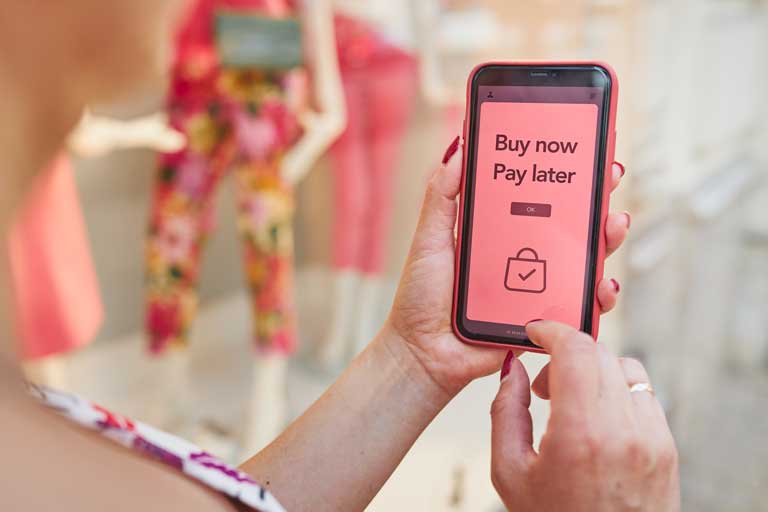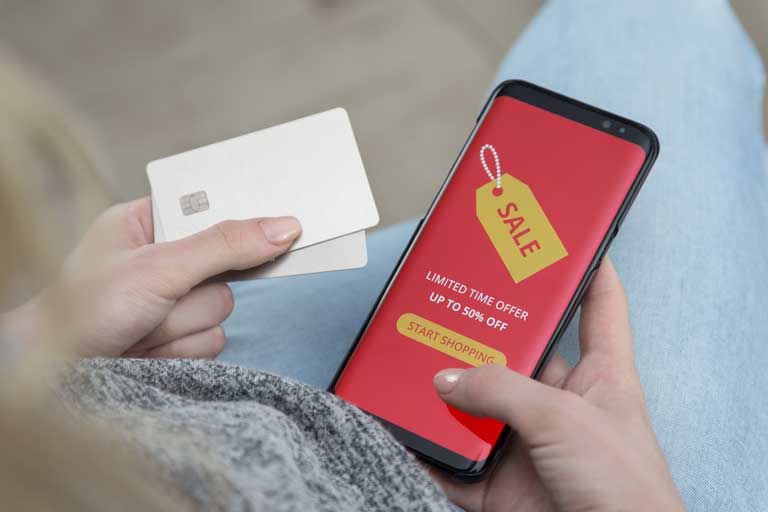There is nothing worse for a small business owner than to have a customer express interest, ready to purchase, and then back out last minute. All because they fear they cannot afford the cost upfront. Watching a customer walk out of your store, or leave an online shopping cart sitting at checkout will make any business owner’s heart sink.
Here’s the problem. Because of inflation, consumer goods and services are getting really expensive! As much as your clients may want that brand new living room set, or desperately need that root canal, or earnestly seek a bathroom renovation, their bank account may simply not allow for it…upfront.
Here’s the great news. We have the solution that will eradicate this pesky problem. For both you and your customers. The answer is as easy as offering consumer financing.
Continue along with us to discover how the simple trick of consumer financing for merchants can change the way your small business profits forever.
The Explosion of Consumer Financing
The idea of paying full price upfront for a high-dollar item makes many consumers uneasy. The huge financial commitment can be a lot for many Americans today. A purchase is much more financially digestible if payments can be split up over time into smaller increments. Although interest would apply, small payments over time can be much less daunting.
Consumer financing for businesses is the answer to this common dilemma. Consumer financing has gained popularity in recent years. The widespread explosion is easy to understand. We are living in a society that is all about instant gratification.
Consumers want things even if they cannot afford them. And they want those things now. With consumer financing options, you can give your customers buying power they otherwise would not have had.
When merchants offer these solutions, it makes their service or product seem more affordable at the time. Additionally, it makes a product or service seem genuinely more desirable. Financing with little to no down payment, and smaller monthly payments result in:
- Overcoming any price objections
- Enhancing customer loyalty
- Increased ticket prices
- Closing more sales
- Larger profit margins
In fact, merchant consumer financing options have proven to increase small business ticket averages from anywhere between 45% to 85%. So, how do we define consumer financing?
What is Small Business Consumer Financing?
Consumer financing for small businesses is a solution for customers who want to make a purchase, but may not have the upfront funds for it. Or they do have the funds, but it would be a huge stretch to their budget. Consumer financing allows customers to pay for costly goods or services broken up over time, rather than all upfront.
This type of personal loan pays the merchant upfront for their goods or services. From there, the consumer receives their product or service instantly and the merchant is paid upfront. It would then be up to the consumer to repay the lender for the loan.
This could be utilized by means of a Buy Now, Pay Later (BNPL) program, an installment loan, or a line of credit. The funds are provided either by the merchant directly, a bank, or a third-party lending company.
For retail financing for customers to be a successful implementation for businesses, there must be confidence that merchants will receive payment in full for their provided goods and services. Regardless of the customer’s ability to make their repayments on time or in full.
Your small business can choose to offer either or both direct-to-consumer and/or direct-to-merchant loans. Direct-to-merchant loans can be more powerful in encouraging smaller purchases and fewer steps in the payment process from the lender, to the consumer, to the merchant.
Whereas direct-to-consumer loans allow customers the opportunity to take responsibility for the loan payment themselves on larger purchases. Let’s explore these options a little further.

Direct-To-Consumer Financing
Consumer loans for small businesses can also be direct-to-consumer financing. Or otherwise known as a personal loan that a merchant can offer in their store. A consumer would apply with a lender, either in-store or online at your website before the point of sale. With these types of loans, there are generally lower credit score requirements. Additionally, the borrower can receive higher funding portions.
Once approved, the lender would then fund the consumer directly. These loan applications can take a few days to process from approval to funding. Depending on the lender, approval can be up to $100,000 or more for each consumer.
Benefits of Direct-To-Consumer Financing
This type of financing is best used for merchants who sell high-priced goods or services. Personal loans typically have higher limits than credit lines. Which is what a direct-to-merchant financing option would essentially be.
Additionally, this type of financing can be beneficial for small businesses that may not meet the strict requirements of a direct-to-merchant financing solution. Reasons for not meeting the requirements may be the business owner’s credit score or credit history, business age, business industry, etc.
The benefit of direct consumer funding is that there is less risk involved for the lender. It is ultimately a hands-off operation on the merchant side when a consumer uses direct-to-consumer lending.
Though the merchant can host the third-party application on their website, they simply wait for the consumer to make a payment to then supply their goods or service. The merchant does not have to pay No credit card transaction fees, they do not have to worry about chargebacks, and the merchant does not need to handle collections.
Disadvantages of Direct-To-Consumer Financing
A disadvantage of consumer loans for the borrower is the payback time. In most cases, repayment would be required over a shorter period of time compared to a direct-to-merchant credit line. In most cases, consumers would have less than 6 years to pay back the short-term loan. Whereas with direct-to-merchant financing, a consumer may have up to 10 years or more.

Direct-To-Merchant Financing
Consumers would apply for Direct-To-Merchant Financing in the merchant location or at home on the merchant’s website. Once a consumer’s financing is approved in-house or on a merchant’s website, the merchant receives direct payment from the lender upfront. The consumer is then responsible for repaying the lender over a period of time. This can sometimes be up to 10 years or more depending on the lender.
Benefits of Direct-To-Merchant Financing
Direct-to-merchant financing offers the easiest way for consumers to commit to moderate to high-priced purchases from hundreds to tens of thousands of dollars. Merchants will assume a small fee to use this option. However, it does reduce consumer responsibility which will ultimately be more attractive to clients.
Disadvantages of Direct-To-Merchant Financing
In comparison with direct-to-consumer financing, lenders have more limitations and requirements for merchant approval for the direct-to-merchant financing option. These include:
- Stricter credit score requirements
- Lower financing limits
- A clean criminal record
- A steady business history
- Up-to-date Secretary of State Registration
- Merchant fees
- A certain annual revenue minimum. This shows evidence of financial responsibility should customer disputes or fraudulent claims arise

Buy-Now-Pay-Later (BNPL) Programs
A buy-now-pay-later (BNPL) program is another way of saying a payment plan. A payment plan is a service that a merchant would offer in-house with no third-party lender or financier involvement.
This option is beneficial to clients who want to avoid paying interest on their purchases as they would with a loan or line of credit. All a client would need to do is apply directly with the merchant.
If approved, they would simply have their payment split into a few months. Because there is no financing involved, these payment plans are not reported to the credit bureaus unless a payment is missed. On the other hand, even if payments are made in a timely manner, there is no credit being built.
However, the lack of interest in a BNPL program may far outway the need to build credit for many consumers. A consumer would be paying less overall compared to a loan or line of credit.
However, merchants beware, if you offer this type of program, you are not paid upfront for your services. Because of this, you may end up with unsecured financials from your customers. Which could result in defaulted payments.
If this happens, it would be detrimental to your business. Furthermore, it would be your responsibility to hire additional staff that would be needed for accounting and collections to be sure the funds are received in full.
Customer Financing Versus Credit Cards
Credit cards can be quite similar to consumer financing. However, there are a few differences that we can discuss to better understand the advantages and disadvantages. Accepting credit cards is a must. An absolute convenience to your client.
With credit cards, consumers can buy something instantly that they may not have the available funds for in their bank account. Consumers use credit cards daily for all sorts of transaction types. Cardholders repay their issuing banks over time with interest or at the end of the month in full. The latter option would have zero interest applied.
Over the years, with properly handled repayment cardholders build their credit portfolio and earn cash back and rewards points. Everyone likes rewards and credit cards offer easy access to earn free things just by paying for items they would have anyway.
But building credit is essential. Good credit helps acquire larger purchases down the road. These purchases can look like cars, houses, or even a personal loan…like the one they may need to complete a transaction at your business!

Credit Limits
However, using credit cards for more expensive and non-routine purchases only works if your client has a high enough credit limit on their card. Because credit cards tend to have lower limits, they may not have enough available room on their card to then purchase higher-priced items that you are offering.
Your customer will be limited with how much they can purchase depending on how much of their limit they have already utilized for other purchases. Additionally, if the item they are trying to purchase exceeds their set amount, they run into a roadblock as well. Limits are all dependent on the cardholder’s credit score, card tier, income, and type of card they have acquired.
This is the benefit of offering additional consumer financing specific to purchasing your goods or services. It allows a consumer to have access to additional funds. They can use their credit card for other necessary items such as groceries, gas, and routine living expenses. And use your financing option to purchase anything additional at your store, office, or eCommerce site.
Supplying alternative access to funding allows your clients to then commit to making a purchase knowing they can pay it off over time. They will not need to skimp on their other purchase needs with their personal credit card.
Chargebacks
Credit cards, although a convenient way to process a transaction has one factor that most merchants cringe at. Chargebacks. Most issuing banks offer consumer protection against all credit card transactions. If a cardholder decides for any reason that they want to dispute a transaction on their card, the merchant is then responsible to provide proof that the transaction was valid.
The cardholder can raise a dispute, whether they are in the right or the wrong. It could be for reasons such as: never receiving the product or service, wrong amount, fraud, unsatisfied with the product or service, etc.
Either way, the banks are legally liable to inform the merchant, reverse the transaction, and charge them an additional fee for the dispute process. Most often than not, the bank will side with the cardholder over the merchant. This means the merchant would lose out on their funds, even if the customer did receive their product or service. Merchants would need to provide solid evidence of the validity of the purchase to have any chance at winning a chargeback.
Interest Rates
When opting for payment via credit card or consumer financing with loans or additional lines of credit, interest will always play a role. However, interest rates on credit cards can rack up much quicker. The average credit card interest in 2022 is currently 19.20%.
When credit cards are being constantly used for daily purchases, this interest will continue to roll over if cardholders do not pay their bill in full at the end of each month. Bills are added on top of each other and the tacked-on interest continues to increase the amount due every month.
However, consumer finance options generally offer much lowers interest rates. This can be as little as 2%. However, it can go up to 40%. The APR would all be dependent on the lender, and the applicant’s credit history.
Moreover, when approved for a loan, the interest rate is fixed on a singular amount. So the interest does not snow pile on top of additional monthly transactions. Simply the original borrowed amount.
Why Should I Offer Consumer Financing?
Small business retailers and service-based merchants can benefit greatly from offering consumer financing. Adopting alternative avenues to assist your clients in affording their purchases can dramatically change the trajectory of your business profits and cash flow. Moreover, you will instantly increase the satisfaction and thus, the loyalty of your valued clientele. Let’s take a look at a few of these key benefits below.

Increase Conversion Rates
No matter the type of small business you run, you will always have competition. To be a successful entrepreneur, your main objective should be to have steady conversion rates from passive shoppers to active buyers.
However, there are always challenges you must face. You may own and operate a small plumbing business. You serve clients that typically need quick fixes to a daily necessity like their sink, toilet, shower, etc. Or you may be a dentist with a patient that desperately needs to fix their tooth. Even in pain, or in emergent need, many patients and clients will look at multiple options before committing to a provider for their goods and services.
Either way, you need to find a path to best outsmart your competition. Money is a huge influence on a person’s decision-making. Offering a simple and easy way to pay for otherwise unaffordable goods and services, such as consumer financing, will increase your conversion rate. Your services instantly become more desirable and seemingly more affordable
Drastically Boost Sales
When conversion rates are increased, your sales, and thus your profits increase. In addition, a consumer’s average ticket price will increase. Furthering your profit margin and cash flow.
Consumer financing is designed to offer smaller monthly payments rather than forking out the entirety of the balance upfront, draining a customer’s bank account. Your clients will find it easier to digest larger purchases. Which will easily encourage larger consumer spending amounts.
Before, your clients may have needed to save up or only purchase the bare minimum. However, financing allows them to buy instantly, select to upgrade, or purchase more than they would have originally been able to afford.

Generates Client Loyalty
Consumer financing makes it easy for your clients to return back to you for any future needs. When they open a line of credit with your store they have a reason to return. And when you can provide your clients easy access to funds for their purchases, you are providing them a gateway to easily say yes time and time again. This generates repeat business and customer loyalty.
How Merchants Can Offer Consumer Financing
When you offer financing solutions to your customers, you are able to capture larger portions of the market clientele and invite more clients to do business with you. Merchants may offer to finance in-house, where the seller directly extends credit.
However, most consumer financing solutions are provided and backed by a third party, like ECS. This is the simplest and most efficient option for merchants. A third-party financier exclusively handles the entire lending process. But the merchant offers the service to the customer through their website in-store or online at a consumer’s home.
This design carries a huge benefit for merchants. With the adaptation of third-party consumer financing solutions, small businesses will have little to no financial risk. It also poses no additional administrative barriers to work through.
Offering in-house financing or payment plans can become a headache. Merchants would need to track customer payments. This would require hiring accountants and making collection calls every month. This option is generally not cost-effective and not where most small businesses need to be spending their valuable time.
When opting to use a third-party financier as you would through companies such as ECS, you leave the collections and financing accounts in the hands of the professionals. This frees up your costs and provides additional time to be dedicated to productivity in other areas of your business. Like selling your goods or services and keeping your customers happy.
When a consumer opts to use your third-party financing payment features, they are now liable to the third party rather than to the merchant. The merchant receives payment even if a consumer does not make their payments on time or at all. There are two ways to accomplish this, direct-to-consumer financing and direct-to-merchant financing.
Consider Your Financing Options
At this point in the article, I hope you’ve fully gained a better understanding of the different types of financing services available to you. And how they can help both you and your clients get more out of your business.
With this knowledge in place, it is now time to deliberate your options. Below are some considerations you may want to think about in determining which option is best for you.
Qualifying For Consumer Lending
First, you will need to determine your likelihood of qualifying for direct-to-merchant consumer lending. As a merchant, you would need to apply with a third-party lender to partner with them to offer their lending services to your clients. To be paid directly by a lender, a merchant needs to be financially responsible, have a decent credit score, and show proof they are a legitimate establishment.
Keep in mind, as with any financing service, approval cannot be guaranteed for either the consumer or the merchant. Only once an application is submitted and reviewed, then this determination can be made.
How Do You Want to Receive Funds?
Next, you will have to decide how you want to receive funds. Is it more important for you to receive funds directly from a third-party lender? Or do you believe receiving funds from your customer would prove to be more effortless? Most merchants understand that receiving funds directly from a partnered lender would be the most seamless. This option can prove to be more trustworthy in making sure a purchase is successful.
However, there is a downside to this option. Along with a more strict application process, you would also run into additional merchant fees. Financiers charge merchants to use their direct-to-merchant consumer financing. Think of it as a service or convenience fee.

Possibility to Raise Prices
Lastly, consider this. When offering financing, customers automatically see this opportunity as a more affordable option. Because of this, you may be able to increase your prices with the same result. Goods that were once unaffordable are now seen as less daunting. Because splitting the total into smaller payments over time is easier on monthly budgets.
Therefore, you can increase prices for the same goods and services. Monthly payments may only increase by a few dollars. This makes consumers less concerned compared to seeing the total price upfront increase by a few hundred dollars.
ECS Makes Consumer Financing Simple
When you partner with ECS today, you can power your business and bring your customers’ dreams to life. Offer your clients quick and competitive lines of credit. With a simple, online application you can provide unsecured consumer loans from $5,000 to $50,000
We offer flexible, merchant-centric, and customizable point-of-sale financing solutions. You will complete more sales with our solution design. Your customer applies online with a link unique to your business. From there they receive a decision in seconds. As soon as the transaction is complete, your business gets paid.
The entire process is paperless. Furthermore, your customer will already have the 3 necessary pieces of information to get started on hand. Their date of birth, email address, and phone number.
We provide the necessary tools and integrations you need to offer convenient funding to your clients. Our user-friendly online interface is seamlessly installed into your business website. Making it easy for your consumers to apply.
Reasons to Partner with ECS’s Consumer Financing Solutions
- Increase profits with loan amounts up to $50,000
- Obtain quick approvals with our easy-to-use and entirely digital solution
- Meet your specific needs with customized Financing programs
- A dedicated success manager ensures your program drives results
- Build loyalty with purchase windows for up to 6 months only at your business

Small Business Consumer Funding Conclusion
You can remain in control with consumer financing. Whether you offer it yourself in-house or through a third-party financial service. You put purchasing power back in the hands of your consumers. Your customers can visualize smarter monthly payments. Oftentimes, they will even have better interest rates than their personal credit cards.
Not only do you afford your consumers better payment options, but you protect yourself as well. Consumer financing can minimize your vulnerability to credit card chargebacks. And it can reduce merchant processing fees.
However, financing and lending services are becoming more and more popular over the years. The evolution of the financing service industry and the consumer marketplace is creating a world dependent on credit over readily available funds..
Because of this, your options to provide a more approachable shopping experience and stimulate your business growth are continually increasing with every year that passes.
You can easily partner with ECS to provide affordable financing solutions to your customers and get the most out of your business. To get started, you can contact us on our website and one of our experts will be in contact with you shortly.
To contact sales, click HERE. And to learn more about ECS Small Business Consumer Funding visit Lending.
